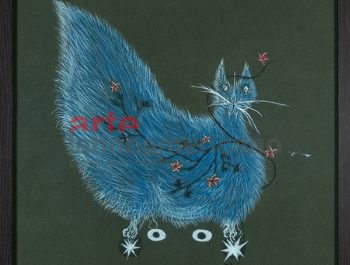In the art world, there has always been room at the table of surreal “crazy” for her. Leonora Carrington (1917-2011) at the age of 18 decided to abandon her traditional English and Victorian bourgeois life. , she could certainly respond with her experiences and with great historical events: studying in Italy after being expelled from several traditional English schools, moving to France, meeting Max Ernst, escaping the Spanish Civil War and Nazism to reach Nova York in the 1940s and then moving to a mysterious green land called Mexico, a red thread of fate that links the history of exiles from the European war.
A curious description of Leonora by the exiled writer Victor Serge:
August 31th, 1943. Surreal night. (…) Leonora Carrington, who was told that she looks like Charles I in the Van Dyck portrait, but in a feminine, soft, hard and crazy version. Slightly upturned nose, dark eyes, intensely smoldering, full of assurance and concern, manifestly schizophrenic. (…) He makes crazy drawings in gouache, fragments of landscape floating on islands, women’s clothing hanging in the sky or in the void, skinned animals, hands splayed here and there, figures of nightmares and dreams drawn in fine pen between leafy greens and light vegetable yellows; all full of little and long writings in which I just read that the universe is the result of couplings from nothing. One of the drawings on the wall is also upside down and we all agree that it should be turned over once every fortnight.
A table that commemorates the teatime of Alice in Wonderland, a girl-woman trapped in a world of adults who dreamed of revolution and change in the face of the catastrophes of her time. Leonora explored surrealism as a language of its own to capture an era full of silent symbolisms that seek to escape all cold rationality in a period that idolizes technique and pragmatic-theoretical language.
We can read and reread any legend within her paintings, the result of interpretations developed throughout her life with themes that fascinated and frustrated her, such as the lost character between the girl in search of reverie and the adult dramatic witch in search of the tale. In the artistic and literary body, exploring her memory images, the symbols of children’s stories and the magical realism of a country that lives trapped in eternal times where life and death are confused under the same territory of different views of the world.
Carrington deeply explores artistic techniques that go beyond the brush, constantly fusing the mystery of the mind, dreams and alchemy as a material way of interpreting reality. In Mexico, she not only yearned constantly to return to England but also dared to unravel the secret Tzotzil and indigenous vision of the country that embraced her.
Ten years after Leonora’s departure, will we know the response of time in her hands, as an embroiderer of rite and myth to preserve part of her reserved identity?
Text written by Mariame Reyes. Translated from Arte Latinoamericano.



